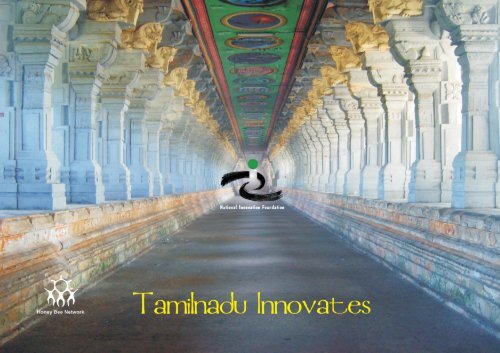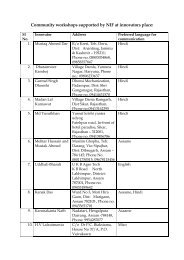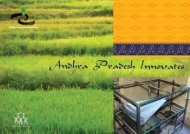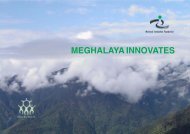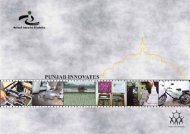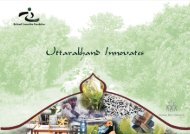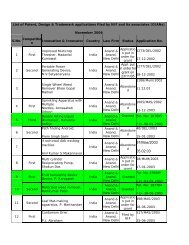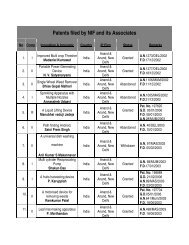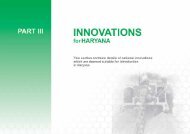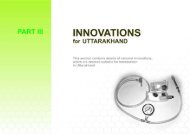Part I OF I Tamil Nadu.pmd - National Innovation Foundation
Part I OF I Tamil Nadu.pmd - National Innovation Foundation
Part I OF I Tamil Nadu.pmd - National Innovation Foundation
Create successful ePaper yourself
Turn your PDF publications into a flip-book with our unique Google optimized e-Paper software.
PREFACE<br />
<strong>National</strong> <strong>Innovation</strong> <strong>Foundation</strong> (NIF) has been pursuing the<br />
mission of making India innovative and a creative society<br />
since 2000 with the active support of Department of Science<br />
and Technology, Government of India. Till date NIF has been<br />
able to scout innovations and traditional knowledge practices<br />
from over 545 districts across India.<br />
Thanks to the support of volunteers from Honey Bee Network,<br />
we have been able to discover many unsung heroes and<br />
heroines of our society who have solved local problems<br />
without any outside help.<br />
Despite various constraints, NIF has put together a small book<br />
celebrating creativity, innovation and traditional knowledge<br />
from <strong>Tamil</strong> <strong>Nadu</strong>. I am conscious of its limitation in terms<br />
of coverage and outreach. But if we could uncover at least<br />
a few examples of the ability of local communities and<br />
individuals to solve problems on their own without outside<br />
help, how much more can be done if state and private sector<br />
agencies join hands with NIF actively.<br />
I invite the state government and its various organs to actively<br />
support our quest to uncover many more creative communities<br />
and individuals in rural and urban areas. NIF will then help<br />
in building value chain around them.<br />
The book is divided in three parts. The mechanical innovations<br />
developed by innovators from <strong>Tamil</strong> <strong>Nadu</strong> are covered in part<br />
one. Selected examples of herbal traditional knowledge are<br />
given in part two. The innovations from other parts of the<br />
country suitable for the development of <strong>Tamil</strong> <strong>Nadu</strong> are given<br />
in part three.<br />
By no stretch of imagination, could we claim that we have<br />
achieved a great deal. We have merely made a simple point.<br />
There are a large number of knowledge rich people who<br />
TAMIL NADU INNOVATES 4
TAMIL NADU INNOVATES<br />
may not have been educated much, may in fact be<br />
economically poor also, but still have the ability to solve a<br />
few problems so well.<br />
The challenge really is to work out a synergy so that no<br />
creative voice remains unheard, and no solution remains<br />
localized and unrecognized. By adapting public policy in<br />
support of grassroots innovators and traditional knowledge<br />
holders, we can make economic development process more<br />
inclusive and sustainable.<br />
This book on innovations has been compiled at the request<br />
of Dr. Vijay Kelkar, Chairman, Finance Commission and the<br />
Member, Governing Council of the <strong>National</strong> <strong>Innovation</strong><br />
<strong>Foundation</strong> as a tribute to the creativity and innovation at<br />
grassroots. This presentation is part of a series of innovation<br />
compendium prepared for every State of India. We hope<br />
this will be followed up in the form of concrete policy and<br />
institutional initiatives in each State to empower creative<br />
people to improve the quality of life of common people and<br />
thus promote inclusive growth.<br />
It is my belief that such examples will act as spur for other<br />
State government departments to look for creative efforts of<br />
their staff and users at ground level. I hope that NIF will<br />
have the opportunity to work closely with the State government<br />
in future and expand knowledge base, add value to selected<br />
technologies and help them diffuse through commercial and<br />
non-commercial social channels for improving the livelihood<br />
of the majority of the people.<br />
R. A. Mashelkar, FRS<br />
Chairperson, Governing Council<br />
<strong>National</strong> <strong>Innovation</strong> <strong>Foundation</strong>, Ahmedabad<br />
mashelkar@nifindia.org<br />
TAMIL NADU INNOVATES 5
Building a Bridge with Grassroots Innovators in Informal Sector<br />
To make the Indian development process more inclusive, there<br />
is no escape from building upon creative and innovative<br />
experiments pursued by common people at village or semiurban<br />
level. Many of these experiments lead to development of<br />
innovations, which can improve productivity and generate<br />
employment. However, the purpose of a particular innovator<br />
may often be to solve just his/her problem. There is no<br />
mechanism available for him to share the knowledge, innovation<br />
or practice with other people in different regions. Sometimes,<br />
ideas and innovations get diffused through word of mouth. But<br />
many times, these ideas remain localized. In the process,<br />
potential growth and social development gets constrained. To<br />
overcome this constraint, Honey Bee Network with a handful of<br />
volunteers triggered a movement, twenty years ago to scout,<br />
spawn and sustain the unaided innovations and outstanding<br />
traditional knowledge from the informal sector of our country.<br />
Drawing upon this experience, <strong>National</strong> <strong>Innovation</strong> <strong>Foundation</strong><br />
(NIF) was set up in 2000 with the help of Department of Science<br />
and Technology, Government of India to scale up the idea of<br />
learning from grassroots innovators.<br />
Under the inspiring leadership of Dr. R. A. Mashelkar,<br />
Chairperson NIF and former Director General, Council of<br />
Scientific and Industrial Research (CSIR), NIF has taken major<br />
initiatives to serve the knowledge-rich, economically poor people<br />
of the country. It is committed to make India innovative by<br />
documenting, adding value, protecting the intellectual property<br />
rights of the contemporary unaided technological innovators,<br />
as well as of outstanding traditional knowledge holders. It aims<br />
at promoting lateral learning among local communities to<br />
generate low cost affordable solutions of the persistent and<br />
emerging problems, and enhance the diffusion of innovations<br />
on a commercial as well as non-commercial basis.<br />
How does NIF work<br />
Primarily, NIF has five functions: (a) Scouting and<br />
documentation, (b) Value addition and research and<br />
1 The Honeybee collects pollen from the flowers but they are not impoverished,<br />
in the process links one flower to another enabling cross-pollination. Similarly,<br />
the Honey Bee Network strengthens people-to-people contacts, learning and<br />
networking by pooling the solutions developed by individuals across the world<br />
TAMIL NADU INNOVATES 6<br />
in different sectors. The network acknowledges the innovators, traditional<br />
knowledge producers and communicators so that they do not remain<br />
anonymous.
TAMIL NADU INNOVATES<br />
development, (c) Business development and Micro Venture, (d)<br />
Intellectual Property Rights protection and (e) Dissemination,<br />
database development and IT applications.<br />
NIF has been entrusted with the responsibility of building a<br />
<strong>National</strong> Register of Grassroots <strong>Innovation</strong>s and Traditional<br />
Knowledge. It is not enough to document or disseminate the<br />
innovations or outstanding traditional knowledge. Value addition<br />
is very important for harnessing the full potential of the idea.<br />
NIF has entered into MOU with CSIR and Indian Council of<br />
Medical Research (ICMR) besides other organizations. CSIR<br />
has allocated funds to support research on grassroots<br />
innovations in CSIR labs. Similarly, ICMR supports<br />
research on such herbal healing knowledge, which<br />
has not been documented in the classical texts and formal<br />
institutional literature. NIF also helps in generating a very large<br />
pool of open source / public domain technologies. A small<br />
number of innovations are also protected by patents and<br />
other IPRs.<br />
For most innovators, attracting risk capital for converting<br />
innovations into enterprise is very difficult. They neither can<br />
offer much collateral nor are they able to develop a business<br />
plan or deal with formal R&D system.<br />
A Micro Venture <strong>Innovation</strong> Fund (MVIF) has been set up with<br />
the help of SIDBI to provide risk capital for technologies at<br />
different stages of incubation. Under single signature, innovators<br />
are trusted and investments are made to help them commercialise<br />
their innovations. Most innovators do not make good entrepreneurs.<br />
For entrepreneurship, one has to make consistent batch by<br />
batch production of products. Innovators are often incorrigible<br />
improvisers. They seldom make two things alike. NIF has helped<br />
such innovators to license their technologies to third party<br />
entrepreneurs. Most of the licenses have been given to small<br />
entrepreneurs and in a few cases, to medium enterprises.<br />
A very elaborate benefit sharing system has been developed,<br />
governed by the Prior Informed Consent (PIC) of the knowledge<br />
The Honey Bee Network strongly believes in sharing knowledge among the<br />
providers of innovations in their own language, which is achieved by publishing<br />
local language versions of Honey Bee newsletter. It also ensures that a fair<br />
share of benefits arising from commercial exploitation of local knowledge and<br />
innovations reaches the innovators and knowledge providers.<br />
TAMIL NADU INNOVATES 7
providers. Attempt is made to share benefits not only with the<br />
innovators but also with their communities and for nature<br />
conservation. In addition, a small part is kept for contingency<br />
support to needy innovators, for R&D stakeholders, promoting<br />
women’s innovations and meeting overhead costs.<br />
It is remarkable that grassroots innovations are generating global<br />
demand, as evident from inquiries from around fifty-five countries<br />
for various technologies, NIF has succeeded in commercializing<br />
products across countries in six continents apart from being<br />
successful in materialising thirty cases of technology licensing<br />
with the help of partner agencies.<br />
What has it done<br />
With major contribution from the Honey Bee Network, NIF has<br />
been able to build up a database of more than 1,00,000 ideas,<br />
innovations and traditional knowledge practices (not all unique,<br />
not all distinctive) from over 545 districts of the country.<br />
NIF has filed 202 patents in India and seven in US and one PCT<br />
application. Out of these, 35 patents have been granted to<br />
grassroots innovations in India and four in US. NIF has funded<br />
113 projects under MVIF to the extent of Rs.1.3 crores. Hundreds<br />
of technologies have diffused through farmer to farmer social<br />
network.<br />
NIF has proved that Indian innovators can match anyone in the<br />
world when it comes to solving problems creatively. Where they<br />
perform better than rest is in generating more affordable<br />
sustainable solutions by using local resources frugally.<br />
Those who see poor only as the consumer of cheap goods, miss<br />
the knowledge richness at the grassroots level. The Poor can be<br />
the Providers also.<br />
The Grassroots to Global (G2G) model that NIF is propagating is<br />
all set to change the way the world looks at the creativity and<br />
innovations at grassroots.<br />
How can state government join hands with NIF<br />
a. NIF has no field extension unit nor does it want to have<br />
one. However, state government has several field<br />
functionaries in the area of agriculture, education, industry,<br />
rural development, women and child care, forestry, etc.<br />
There can be a very fruitful partnership between NIF as a<br />
TAMIL NADU INNOVATES 8
TAMIL NADU INNOVATES<br />
source of innovative ideas and technologies and state<br />
government as partner in dissemination, value addition and<br />
even commercialization through incentives, promotion,<br />
subsidies, etc.<br />
b. State government can join the national campaign for<br />
scouting innovations and traditional knowledge and motivate<br />
its grassroots functionaries to join hands with NIF in<br />
uncovering the talent at the community level.<br />
c. Students in schools and colleges can be motivated to scout<br />
creative and innovative people in their neighbourhoods<br />
and send the entries to NIF (Post Box No.15051, Ambavadi,<br />
Ahmedabad 380 015, campaign@nifindia.org). Examples<br />
of innovations can also be included in the curriculum for<br />
the school and college education.<br />
d. Demonstrations and trials can be organized at various<br />
regional research stations and KVKs (Krishi Vigyan<br />
Kendras) so as to create awareness about the creative<br />
potential of common people.<br />
e. The research institutions can be mandated to add value to<br />
the knowledge of innovative people and help in protecting<br />
their knowledge rights.<br />
f. On the state’s website, link to NIF can be given and the<br />
innovations from the region can be displayed to put forward<br />
the creative face of the state before the people.<br />
g. Some of the innovative people identified by NIF and/or<br />
state government could be awarded at district and state<br />
level besides giving them support for further work.<br />
h. A nodal officer could be appointed to keep in dynamic<br />
touch with NIF to ensure that all the areas of possible<br />
cooperation are explored.<br />
I hope that NIF would be able to develop a functional, fruitful and<br />
fulfilling relationship with the State of <strong>Tamil</strong> <strong>Nadu</strong>. Tremendously<br />
rich knowledge of biodiversity and environment besides numerous<br />
grassroots innovations can be leveraged through the proposed<br />
collaboration.<br />
Anil K Gupta<br />
Executive Vice Chairperson, NIF, Ahmedabad<br />
Professor, Indian Institute of Management,<br />
Ahmedabad<br />
anilg@nifindia.org<br />
TAMIL NADU INNOVATES 9
“<strong>Innovation</strong> opens up new vistas of knowledge and new<br />
dimensions to our imagination to make everyday life<br />
more meaningful and richer in depth and content”.<br />
- Dr APJ Abdul Kalam<br />
“The purpose of innovation is to create a new value for<br />
an individual, team, organization or for society at large”.<br />
- Dr RA Mashelkar
01<br />
PART I : INNOVATIONS FROM TAMIL NADU<br />
Chinna Ponni: A popular variety of paddy<br />
C Rajendran<br />
Madurai<br />
Rajendran started his informal research for developing a better paddy variety in 1989.<br />
He soon identified and developed a variety of paddy called Parani. In 1991 he released<br />
it for use by the farmers in his neighbourhood. This variety had a maturity period of 105-<br />
115 days, excellent drought tolerance, resistance to pests and disease and higher yields<br />
giving much higher net profit per acre. Then he developed the Visakam variety which<br />
could withstand water logging due to heavy rainfall. But his experimentation finally paid<br />
off in 1994 when he developed a superior variety which he called Chinna Ponni.<br />
People from all over <strong>Tamil</strong> <strong>Nadu</strong> started enquiring about this high yielding, drought<br />
resistant and disease resistant paddy variety and a few years ago, upto 1/3rd of <strong>Tamil</strong><br />
<strong>Nadu</strong>’s paddy growing area sowed the Chinna Ponni paddy variety. He received a<br />
<strong>National</strong> award in NIF’s First <strong>National</strong> Competition for Grassroots <strong>Innovation</strong>s and<br />
Traditional Knowledge Practices in 2001.<br />
* Though awarded earlier,<br />
the innovator is a<br />
professional as per the<br />
present rules of NIF, which<br />
were redefined 2003<br />
onwards to specifically focus<br />
on innovations from the<br />
people of unorganised<br />
sector.<br />
TAMIL NADU INNOVATES 12
PART I : INNOVATIONS FROM TAMIL NADU<br />
02<br />
Simple coffee pulper<br />
A coffee berry pulper has been developed by Sudhakar to extract the coffee seed<br />
separately without much damage to the fruit. This is a simple hand operated device,<br />
which is compact in size. It can be easily dismantled into small units, transported and<br />
assembled wherever it is needed for the purpose. In a round disc there are slots to fit the<br />
size of the coffee berry. The fruits are fed into the device through a side pipe. Operating<br />
the handles on either side rotates the wheels, which help in separating the pulp without<br />
damaging the coffee bean. The pulp will come out through another pipe and get collected.<br />
The capacity is up to 30 kilos in each operation, depending upon the diameter of the<br />
disc. For instance, a disc of one foot of diameter will operate up to 15 kilos of coffee<br />
beans at a cost of Rs 5,000 per unit, whereas a bigger disk of 1.25 feet diameter, whose<br />
capacity is for 20 kilos, will cost around Rs 6,500.<br />
N Sudhakar<br />
Dindigul<br />
He received a Consolation award in NIF’s First <strong>National</strong> Competition for Grassroots<br />
<strong>Innovation</strong>s and Traditional Knowledge Practices in 2001.<br />
TAMIL NADU INNOVATES 13
03<br />
PART I : INNOVATIONS FROM TAMIL NADU<br />
Spathe cutting instrument<br />
‘Spathe’ is the part of the plant evolving into a flower. In the southern districts of <strong>Tamil</strong><br />
<strong>Nadu</strong> there are millions of ‘palmirah’ (Borassus flabelliformis) trees. The spathe of these<br />
trees yield a sweet juice used to make black sugar. Extracting this juice, however, is not<br />
an easy job.<br />
R Muruga Selvan<br />
Thoothukdi<br />
The average height of a palmirah tree is about a 100 feet and a worker has to climb the<br />
tree more than three times a day to extract all the juice. Selvan has come up with a<br />
simple device to reduce this workload. His instrument has a long rod with a knife at the<br />
end, which is connected with an electric motor through wheels having teeth. The motor<br />
is connected with a timer circuit through which 12 DC current is passed. A small plastic<br />
box is attached around each spathe as well as at the bottom of the tree. When current is<br />
passed through the circuit the motor rotates, which causes the attached knife to make a<br />
small cut in the portion of the spathe. The timer circuit ensures that the motor rotates<br />
thrice every day and the sweet juice keeps flowing from the spathe.<br />
Workers can easily collect the juice from the bottom plastic box without having repeatedly<br />
to climb the tree. He received a consolation award in NIF’s First <strong>National</strong> Competition<br />
for Grassroots <strong>Innovation</strong>s and Traditional Knowledge Practices in 2001.<br />
* Though awarded earlier,<br />
the innovator is a<br />
professional as per the<br />
present rules of NIF, which<br />
were redefined 2003<br />
onwards to specifically focus<br />
on innovations from the<br />
people of unorganised<br />
sector.<br />
TAMIL NADU INNOVATES 14
PART I : INNOVATIONS FROM TAMIL NADU<br />
04<br />
Relay switch<br />
Ponnusamy, an illiterate farmer, has many innovations to his credit. He runs a motor<br />
rewinding workshop and owns two acres of land. Since his land is adjacent to the forest<br />
area, it is frequently subject to attack by wild animals. To protect it, he set up electric<br />
fencing around it. The voltage is enough to give a shock without causing fatal injury.<br />
However, a major problem was that the electric motor kept running even when the water<br />
in the well was exhausted. This affected the life span of the motor pumpset.<br />
He invented a relay switch that automatically stopped the motor when there was no water<br />
left in the well or the tank. The switch however was also designed to stop in case of major<br />
electricity fluctuations. Ponnusamy had redesigned the coil to increase the voltage from<br />
350V to 440V, rather than having the motor stopped, to ensure continuity of running. He<br />
received a Consolation award in NIF’s First <strong>National</strong> Competition for Grassroots<br />
<strong>Innovation</strong>s and Traditional Knowledge Practices in 2001.<br />
Ponnusamy<br />
Virudunagar<br />
TAMIL NADU INNOVATES 15
05<br />
PART I : INNOVATIONS FROM TAMIL NADU<br />
Conversion of circular motion to reciprocating motion<br />
Joshua Devathathan<br />
Chennai<br />
Joshua Devanathan has a surprisingly strong mechanical bent of mind for a Christian<br />
Pastor. He was very worried about the loss of power in the “Slider Crank” mechanism<br />
due to the side-thrust caused by the angular motion of the connecting rod with the crank.<br />
The Slider Crank mechanism is the most commonly applied mechanism in mechanical<br />
engineering for the conversion of reciprocating motion to circular motion. In his innovation<br />
the power transmitting end of the connecting rod does not move in a circular motion as<br />
before, but travels vertically up and down or horizontally to the sides, thus reducing the<br />
loss of power. His innovation is of particular use for both two and four wheeler<br />
automobiles, and for lathes, pumps, jigsaws, handtools etc. He received a Consolation<br />
award in NIF’s First <strong>National</strong> Competition for Grassroots <strong>Innovation</strong>s and Traditional<br />
Knowledge Practices in 2001.<br />
TAMIL NADU INNOVATES 16
PART I : INNOVATIONS FROM TAMIL NADU<br />
06<br />
Environment friendly oil engine<br />
Akasi had set up a shop armed with a high-speed oil engine compressor, which generated<br />
sound and smoke pollution. The annoyed neighbours who complained about the same,<br />
demanded that he be shifted elsewhere. Akasi hence had to invent a silencer with<br />
minimum sound pollution and with lesser smoke emission levels. He first converted his<br />
high-speed engine into a low-speed one and increased the muffler size from 10 inches<br />
to 20 inches. Next, he cut three tin sheets, of 20 inches diameter each, and carefully<br />
welded them together, keeping a gap of two mm between the sheets. He also made<br />
holes similar to those he had observed in the old muffler. He fitted this new modified<br />
muffler into the silencer tube.<br />
M Akasi<br />
Sivakasi<br />
The advantages of this modification are that the sound and smoke produced are much<br />
less with this device and cleaner smoke is emitted, indicating lesser amount of carbon<br />
monoxide in the smoke. He received a Consolation prize in NIF’s First <strong>National</strong><br />
Competition for Grassroots <strong>Innovation</strong>s and Traditional Knowledge Practices in 2001.<br />
TAMIL NADU INNOVATES 17
07<br />
PART I : INNOVATIONS FROM TAMIL NADU<br />
Automatic saree border weft insertion: Combining<br />
tradition with modern<br />
P L Banumurthi<br />
Thiruvannamalai<br />
During his childhood, P L Banumurti and his family constantly struggled to make ends<br />
meet by weaving sarees. As an adult, he devoted his career to improving handloom<br />
systems to make weaving a profitable endeavor. Traditional Korvai or ‘contrast’ weaving<br />
involves intricate work where the design and the colour of the borders are often different<br />
from those of the main body of the sari. Three shuttles are needed: the weaver operates<br />
two, and an assistant operates the third. Banumurthi’s automated system is similar to<br />
the “Catch Cord Technique drawing device for looms” (United States Patent 4616680,<br />
1984) but developed independently, so that no assistant is needed and the productivity<br />
is increased. He has already installed one such device in Madurai district and trained<br />
about 15 women weavers with the help of SEVA.<br />
He received a <strong>National</strong> award in NIF’s Fourth <strong>National</strong> Competition for Grassroots<br />
<strong>Innovation</strong>s and Traditional Knowledge Practices in 2007.<br />
TAMIL NADU INNOVATES 18
PART I : INNOVATIONS FROM TAMIL NADU<br />
08<br />
Continuous weft feeding looms<br />
Shanmugam’s inspiration for innovation comes from his desire to improve the livelihood<br />
of his traditional weaving community. Shanmugam first observed the time and manpower<br />
wasted in changing the pirn windings of power looms while working in his uncle’s power<br />
loom centre. To address this problem, he built a modification to the shuttle loom that<br />
continuously inserts weft without frequent pirn change. In this new method, two weft cone<br />
stands are placed at the sides of the loom, and are specially arranged so that they can<br />
control yarn tension and electronic weft stop motion. This inexpensive and easy to maintain<br />
system increases productivity by 15-20% and increases fabric quality and reduces labour<br />
need. He got admission in not only polytechnic directly in second year but also in<br />
engineering college later due to his brilliance.<br />
S Shanmugam<br />
Salem<br />
He received a <strong>National</strong> award in NIF’s Fourth <strong>National</strong> Competition for Grassroots<br />
<strong>Innovation</strong>s and Traditional Knowledge Practices in 2007.<br />
TAMIL NADU INNOVATES 19
09<br />
PART I : INNOVATIONS FROM TAMIL NADU<br />
Idea: Minding money and saving electricity: Reading<br />
meters in rupees<br />
G Satish Kumar<br />
Madurai<br />
G Sathish Kumar has been blessed with an insatiable curiosity since early childhood.<br />
He has already received numerous awards and accolades for his innovations. He<br />
developed an idea of developing electricity meters that display the amount of electricity<br />
consumed in terms of money (Rupees) rather than power units (Kilowatt Hours). This<br />
innovation might encourage consumers to keep tab on their energy expenditure and<br />
conserve power when possible. Satish also suggests enacting a “prepaid system” wherein<br />
customers could buy power units at the beginning of the month and check their balance<br />
on the meter, reducing consumption or purchasing more energy units as necessary.<br />
This prepaid system will also benefit energy companies, which can easily cut off power<br />
supply as the balance on the SIM card runs dry and restore it when the card is renewed.<br />
He received an award under student’s category for his idea in NIF’s Fourth <strong>National</strong><br />
Competition for Grassroots <strong>Innovation</strong>s and Traditional Knowledge Practices in 2007.<br />
TAMIL NADU INNOVATES 20
PART I : INNOVATIONS FROM TAMIL NADU<br />
10<br />
Dual purpose rotary huller<br />
Hulling is an essential part of food processing, especially in rural India. Unfortunately,<br />
the available mechanical hullers are very expensive and people are often forced to go to<br />
long distances for processing food grains. Manoharan from Madurai has found a lowcost,<br />
easy-to-maintain and operate dual-purpose rotary huller. The huller has six hollow<br />
cylinders with inset plungers, fixed in a triangular shape on each side of a circular disc.<br />
Since the six cylinders are not connected, one can grind six items at the same time. The<br />
hollow tube with the plunger arrangement is designed in such a way that the disc is<br />
equally balanced with the hollow tubes. Therefore minimum power is required to start<br />
and maintain the rotation of the circular disc with tubes.<br />
When the circular disc is rotated, the plungers pulverize<br />
the material put inside the hollow tube. The amount of<br />
heat produced during the process of hulling is reduced<br />
and so the original flavour of the product is maintained.<br />
The rotary huller can be operated manually or by using<br />
electricity.<br />
It can be used to grind herbal and non-herbal products<br />
for medicines, animal waste for producing fertilizers and<br />
also mix and grind various grocery items. He received<br />
support from the Micro Venture <strong>Innovation</strong> Fund (MVIF)<br />
for developing the rotary huller. He also received the<br />
State award in NIF’s Third <strong>National</strong> Competition for<br />
Grassroots <strong>Innovation</strong>s and Traditional Knowledge<br />
Practices in 2005.<br />
TAMIL NADU INNOVATES 21<br />
A N Manoharan<br />
Madurai<br />
* Though awarded earlier,<br />
the innovator is a<br />
professional as per the<br />
present rules of NIF, which<br />
were redefined 2003<br />
onwards to specifically<br />
focus on innovations from<br />
the people of unorganised<br />
sector.
11<br />
PART I : INNOVATIONS FROM TAMIL NADU<br />
Hand operated water lifting device<br />
An efficient way of pumping water to meet requirements in a cost effective way is always<br />
a challenge in rural India.<br />
N Sakthimainthan<br />
Thiruvarur<br />
Developed from locally available materials, this hand operated water lifting device is<br />
simple in design, delivers high discharge and is low cost compared to conventional hand<br />
pump, bucket pump, and bicycle operated pumps.<br />
He received a Consolation award in NIF’s Fourth <strong>National</strong> Competition for Grassroots<br />
<strong>Innovation</strong>s and Traditional Knowledge Practices in 2007. NIF also filed a patent for this<br />
device in the innovator’s name. The <strong>Innovation</strong> has been taken up for value addition at<br />
CMERI Durgapur (WB) through the NIF-CSIR JIC Fellowship Scheme.<br />
TAMIL NADU INNOVATES 22
PART I : INNOVATIONS FROM TAMIL NADU<br />
12<br />
Groundnut sowing practice<br />
Mukunthan has developed a sowing technique for groundnut crop. The method involves<br />
creation of a raised bed with furrows on both the sides. The seeds are then dribbled in a<br />
triangular shape. The technique saves labor and conserves water without any loss in<br />
the yield of the crop. This method also reduces seed rate (10 kg of groundnut seeds are<br />
saved per acre) and cost of weeding. Water requirement is reduced by about 62% and<br />
this method facilitates faster irrigation and maintains good soil aeration. The crop is also<br />
easier to harvest compared to plants sowed conventionally. Mukunthan has been<br />
practicing organic farming for the past 15 years. His other innovations include the use of<br />
water hyacinth as green manure and for mulching and the design of a country seed drill,<br />
which delivers four seeds with nine inch spacing.<br />
P B Mukunthan<br />
Chinglepet<br />
He received a Consolation award in NIF’s Third <strong>National</strong> Competition for Grassroots<br />
<strong>Innovation</strong>s and Traditional Knowledge Practices in 2005.<br />
TAMIL NADU INNOVATES 23
13<br />
PART I : INNOVATIONS FROM TAMIL NADU<br />
Sanitary napkin making machine: An option for women<br />
entrepreneurship<br />
Sanitary napkins, a universally needed product, have a very low penetration in India<br />
due to high price and the traditional trend of using cheaper but unhygienic old cloth<br />
pieces. The innovator has developed a machine that produces quality sanitary napkins<br />
at a low cost.<br />
A Muruganandam<br />
Coimbatore<br />
One can prepare sanitary napkins with industry standard raw materials while cutting<br />
down the cost in production. It requires three to four persons to produce two pads per<br />
minute. Costing less than half of conventional options, this machine produces sanitary<br />
pads @ Rs.1 to Rs. 1.50 per pad approximately.<br />
The innovator prefers to sell the napkin making machinery only to self-help groups of<br />
women. He has also designed a napkin vending machine such that one can put a coin<br />
and get a pad. With the support from the Micro Venture <strong>Innovation</strong> Fund scheme of NIF,<br />
the innovator has been able to install over fifty units in seven states.<br />
TAMIL NADU INNOVATES 24
PART I : INNOVATIONS FROM TAMIL NADU<br />
14<br />
Garlic peeling and lemon cutting machine<br />
Faster peeling of garlic in an effective way is a major requirement in the pickle industry.<br />
This product is a food-grade, fully automated machinery designed for bulk quantity peeling<br />
of garlic. The machine ensures minimal damage and has wide application in making<br />
pickles and herbal medicines. The machine is energy efficient, saves labour, and has<br />
low capital and operating cost. It frees the industry from capacity constraints caused by<br />
shortage of labour in peak seasons.<br />
The second product is also used in pickle industry, but for cutting lemons. It is a cost<br />
effective machine, having innovative design, with continuous feeding system. It performs<br />
precise and standard cutting of large quantity of lemons in uniform shape and size. It can<br />
be operated by one person and cuts lemon into eight equal pieces. The innovator has<br />
been able to run a good business with the financial support of Micro Venture <strong>Innovation</strong><br />
Fund and marketing effort of NIF. He received a <strong>National</strong> award in NIF’s Third <strong>National</strong><br />
Competition for Grassroots <strong>Innovation</strong>s and Traditional Knowledge Practices in 2005.<br />
M Nagarajan<br />
Madurai<br />
TAMIL NADU INNOVATES 25
15<br />
PART I : INNOVATIONS FROM TAMIL NADU<br />
A new valve modification for two-stroke engines<br />
D Subramanian<br />
Erode<br />
D Subramaniam has developed a two - stroke engine for two wheelers, which reduces<br />
petrol expenses and environmental pollution. The two-stroke engines cause leakage of<br />
petrol-air mixture and lead to environmental pollution and wastage of fuel running into<br />
crores of rupees. So Subramaniam decided to modify it to overcome this drawback. In<br />
his modified engine, the smoke outlet has been located at the top of the cylinder, so that<br />
the petrol mixture does not mix with the smoke and there is no possibility of leakage. For<br />
two stroke engines with more rpm, he has used two valves, at the top of the cylinder,<br />
which work alternatively as smoke outlets.<br />
Subramaniam has also designed a new metric system for a clock and a new method of<br />
bio-gas production. He received a Consolation award in NIF’s Third <strong>National</strong> Competition<br />
for Grassroots <strong>Innovation</strong>s and Traditional Knowledge Practices in 2005.<br />
TAMIL NADU INNOVATES 26
PART I : INNOVATIONS FROM TAMIL NADU<br />
16<br />
Palm/coconut leaf weaving machine<br />
T S Pasupathy Marthandan, a farmer, has devised a mat-making machine that serves to<br />
reduce the drudgery of workers in the mat-making industry. This low cost machine, which<br />
may be operated by handle or pedal, can be adjusted for either crisscross knitting or V-<br />
shaped knitting and the mats turned out may be used for packing items such as fish,<br />
matches and jaggery. With minor modifications this machine can also be used for korai<br />
pai weaving (korai pai is a mat traditionally used as mattress).<br />
The mat-making machine comprises a frame, two palm-leaf folders, a roller, a crosspave<br />
section and two pedal levers. It enables a skilled operator along with an unskilled<br />
person to produce about six mats of the size 2x4 feet in one hour. With a capital investment<br />
of about Rs 10,000 and a working capital of about Rs 2,500 required for the raw material<br />
of leaves, one can earn a net income of about Rs 75 per day (this earning is calculated<br />
after deducting interests on capital, rent, maintenance, sales commission, etc.). With<br />
manual mat making one can barely earn Rs 25 a day. This machine means increased<br />
productivity and revenue for those engaged in weaving mats from leaves; this also equips<br />
them to compete with the manufacturers of cheaper plastic mats. He has also developed<br />
a leaf splicer, which binds leaves in thin strips required for weaving mats. He received a<br />
<strong>National</strong> award in NIF’s Second <strong>National</strong> Competition for Grassroots <strong>Innovation</strong>s and<br />
Traditional Knowledge Practices in 2002.<br />
T S Pasupathy<br />
Marthandan<br />
Tirunelveli<br />
TAMIL NADU INNOVATES 27
17<br />
PART I : INNOVATIONS FROM TAMIL NADU<br />
Coconut husker<br />
R Jayaseelan<br />
Virudhnagar<br />
Anybody involved in growing and selling coconuts would vouchsafe for the fact that<br />
husking them is certainly one of the more tedious parts of the job. Jayaseelan has<br />
developed a simple labour saving mechanical device for husking coconuts. This device<br />
runs on a 1.5 hp motor and has two sharp blades attached to a cylindrical metal rod,<br />
which is useful in husking more coconuts as compared to the manual effort. With this<br />
device the husk can be separated into four pieces still leaving some coir fibres in the<br />
nuts. He has developed several modified and scaled up versions later.<br />
He received the State award in NIF’s First <strong>National</strong> Competition for Grassroots<br />
<strong>Innovation</strong>s and Traditional Knowledge Practices in 2001.<br />
TAMIL NADU INNOVATES 28
PART I : INNOVATIONS FROM TAMIL NADU<br />
18<br />
Crossing in coconut trees & Air energised pressure<br />
cooker<br />
Duraisamy had produced hybrid coconuts crossing tall and dwarf coconut varieties. He<br />
used to keep the seedlings up to three years in the nursery, then put them in sacks filled<br />
with soil for one month before planting in the main field. He claims that if such a method<br />
is adopted, the planted seedlings start yielding within two years by this method.<br />
Duraisamy noticed that a lot of heat was wasted through the exhaust of the engine used<br />
for pumping water. He took an old oil engine and used it as a compressor. The exhaust<br />
of the oil engine used for pumping water was taken as input in the compressor. He took<br />
a pressure cooker and made two holes at the bottom. He then led hot compressed air<br />
through one of the holes in the cooker, which came out through the other hole. The<br />
container in the cooker acted as a heat exchanger. The cooker was thus ready to cook<br />
food through the heat of compressed air.<br />
K R Duraisamy<br />
Erode<br />
He has also made a modified stove with three different heating plates using central<br />
chamber heat, and also capturing wasted heat though oil chambers around the stove.<br />
He was supported under the Value<br />
Addition, Research and Development<br />
(VARD) fund of NIF. He received a<br />
Consolation award in NIF’s First <strong>National</strong><br />
Competition for Grassroots <strong>Innovation</strong>s<br />
and Traditional Knowledge Practices in<br />
2001.<br />
TAMIL NADU INNOVATES 29
19<br />
PART I : INNOVATIONS FROM TAMIL NADU<br />
Increasing mango yield through cross-pollination<br />
S Nanda Kumar<br />
Coimbatore<br />
Nanda Kumar has developed a simple practice to increase mango yield by planting<br />
sunflower plants on the bund of mango orchard. When mango trees are at the flowering<br />
stage, sunflower plants are cultivated on the sides of bunds. Honeybees, which are<br />
attracted by the sunflower, also rest on the mango flowers. This facilitates crosspollination.<br />
The yield of mangoes is therefore increased. He received a consolation<br />
award in NIF’s First <strong>National</strong> Competition for Grassroots <strong>Innovation</strong>s and Traditional<br />
Knowledge Practices in 2001.<br />
TAMIL NADU INNOVATES 30
PART I : INNOVATIONS FROM TAMIL NADU<br />
20<br />
Control of Eriophyid mite in coconut<br />
Eriophyid mite is prevalent in most coconut growing regions of South India. This pest<br />
has spread from Kerala to <strong>Tamil</strong> <strong>Nadu</strong>.The nuts shrink and become small in size, which<br />
affects their marketability. Further minute cracks and dryness is found on the husk, which<br />
makes the husking operation difficult. Consequently, the coconut growers incur<br />
considerable loss.<br />
To solve this problem, K Chellamuthu has developed a herbal formulation, which prevents<br />
this mite in a natural way. He takes equal amounts (one kg) of leaves of Custard apple<br />
(Annona squamosa), turmeric rhizome, peenari changu (Clerodendrum inermi),<br />
chothukatralai (Aloe vera), nochi (Vitex negundo) and neem (Azadirachta indica) kernel.<br />
All the ingredients are ground into a paste by adding sufficient water. This way about five<br />
litre of juice is extracted. This is diluted with another 15 litre of water. This herbal extract<br />
is administered into the crown region at the rate of two litre per palm after the harvest of<br />
nuts. This can be repeated once in two months i.e. during each harvesting time. K<br />
Chellamuthu has been awarded SRISTI Sanman in February 2000 (Honey Bee: 11(3):6,<br />
2000). He received a <strong>National</strong> Award in NIF’s Second <strong>National</strong><br />
Competition for Grassroots <strong>Innovation</strong>s and Traditional Knowledge<br />
in 2002. SEVA and SRISTI have extended Micro Venture support<br />
for testing and commercialization of this herbal pesticide.<br />
K Chellamuthu, Erode<br />
&<br />
V S Samyappan,<br />
Kunninathur<br />
Samyappan also uses Aloe vera, Vitex negundo and neem cake<br />
against eriophyid mite in coconut. He applies these ingredients<br />
around the trunk of the tree followed with the covering of cowdung<br />
slurry (Honey Bee: 11(1):16, 2000)<br />
TAMIL NADU INNOVATES 31
21<br />
PART I : INNOVATIONS FROM TAMIL NADU<br />
Mini tractor drawn ridger weeder<br />
P K Jeyakrishnan<br />
Erode<br />
This ridger weeder, which can be attached to a mini tractor, performs the weeding as<br />
well as earthing up operations simultaneously. Hence, there is no need for a separate<br />
weeding operation prior to earthing up. The ridger is developed as an attachment to the<br />
three point hydraulic linkage of the mini tractor and comprises an upper main frame, a<br />
central shank and a ridger bottom.This unique ridger-weeder saves operational cost<br />
and time by more than 60 per cent. Since, it helps in trash mulching and obviates the<br />
need for burning the same, it also contributes towards conserving moisture and improving<br />
organic content in the soil. He received a Consolation award in NIF’s Second <strong>National</strong><br />
Competition for Grassroots <strong>Innovation</strong>s and Traditional Knowledge Practices in 2002.<br />
TAMIL NADU INNOVATES 32
PART I : INNOVATIONS FROM TAMIL NADU<br />
22<br />
Plant protection practices<br />
a) Discolouration in bhindi (Abelmorchuos esculentus) & Chilli leaf spot and Powdery<br />
Mildew Disease<br />
Juice is extracted from the leaves of Prosopis juliflora and diluted with water. When<br />
bhindi pods are discoloured (light yellow or white) the same extract is sprayed on the<br />
fields. It is also sprayed in Chilli (Capsicum spp) fields two months after planting for<br />
controlling the leaf spots and powdery mildew disease. For spraying one acre, three litre<br />
of leaf extract suffices.<br />
V K Jayaveeran<br />
Madurai<br />
b) Pests and diseases of Paddy<br />
Sacks filled with eight kg of ‘neem’ cakes are immersed in irrigation channels to control<br />
stem borer, gall fly and bacterial wilt. The ‘neem’ cake is used 18 to 20 days after planting<br />
and has to be supplemented every 25 days.<br />
c) Green Algae<br />
For controlling algae in irrigation wells<br />
that choke the foot-value of pumps,<br />
one bundle of dried paddy straw (about<br />
20 kg weight) is chopped into small<br />
particles and immersed in the water.<br />
TAMIL NADU INNOVATES 33<br />
He received a Consolation award in<br />
NIF’s First <strong>National</strong> Competition for<br />
Grassroots <strong>Innovation</strong>s and<br />
Traditional Knowledge Practices in<br />
2001.
23<br />
PART I : INNOVATIONS FROM TAMIL NADU<br />
New acid lime variety<br />
V Antony Samy<br />
Tirunelveli<br />
Antony Samy used his considerable experience in acid lime cultivation and developed<br />
a new variety of acid lime (Citrus aurantifolia) by grafting rootstock of wild citrus with an<br />
ordinary Edward citrus variety. The grafted plants are drought tolerant, short in stature<br />
and resistant to quick wilt. These plants grow fast and need less water. Moreover, 90%<br />
of its fruits are of the first grade quality as compared to 60% in the popular variety. The<br />
plants start bearing fruits from the third year onwards as opposed to the fifth year in local<br />
varieties and the yield is higher at 30,500 kg per hectare compared to 20,500 kg per<br />
hectare for the local variety. The fruits are bigger in size, juicier and tastier and thus are<br />
more suitable for pickle and other processing industries. This variety fetches a good<br />
price in local markets. Sixty-two year old Samy is the moving spirit behind the Small<br />
Farmers Agricultural Engineering Service Centre, which has been active in Puliangudi<br />
(Kerala) since 1975.<br />
He received a <strong>National</strong> award in NIF’s Third <strong>National</strong> Competition for Grassroots<br />
<strong>Innovation</strong>s and Traditional Knowledge Practices in 2005.<br />
TAMIL NADU INNOVATES 34
PART I : INNOVATIONS FROM TAMIL NADU<br />
24<br />
A new cardamom variety- PNS Vaigai<br />
P N Surulivel has been cultivating cardamom and coconut for long. He has developed a<br />
new variety of cardamom, which has significantly higher yield and recovery percentage<br />
than the popular local variety. He has also been appreciated and awarded by the Spices<br />
Board, Cochin for his efforts in 2003. He was very successful in selling his bold and<br />
green colored cardamom in Satvik- the traditional food festival organised by SRISTI in<br />
2006 at almost twice the local price. He received a <strong>National</strong> award in NIF’s Fourth <strong>National</strong><br />
Competition for Grassroots <strong>Innovation</strong>s and Traditional Knowledge Practices in 2007.<br />
P N Surulivel<br />
Theni<br />
TAMIL NADU INNOVATES 35
25<br />
PART I : INNOVATIONS FROM TAMIL NADU<br />
Shaving, cutting and grinding: Three innovations for<br />
sugarcane farmers<br />
Late Ganesamurthy<br />
Asari<br />
Cuddalore<br />
Ganesamurthy Asari was born and raised in a sugarcane-farming district. He ran a tractor<br />
repair shop and was very keen to develop practical, low-cost solutions for the problems<br />
faced by the farmers in that area. He had developed three useful implements to help<br />
sugarcane farmers. The first invention is a tractor operated stubble shaver, which enables<br />
farmers to cut stubble closer than possible with the conventional swinging blade models.<br />
The second is a power tiller operated stubble shaver that operates in a manner similar<br />
to the tractor-based model described above. The third innovation is a sugarcane trash<br />
grinder that crushes wastes to particles ranging in size from 2-20 mm, increasing the<br />
speed of the composting process and preparing easily digestible fodder for animals.<br />
He received a <strong>National</strong> award in NIF’s Fourth <strong>National</strong> Competition for Grassroots<br />
<strong>Innovation</strong>s and Traditional Knowledge Practices in 2007.<br />
TAMIL NADU INNOVATES 36
PART I : INNOVATIONS FROM TAMIL NADU<br />
26<br />
Effective sound speaker system<br />
Pakkyanathan, who has been running the business of renting music sound system<br />
observed the poor attenuated vibratory motion and acoustic sound wave with the existing<br />
sound speakers. To overcome these problems and to achieve a dramatic sound effect,<br />
he designed a circular speaker assembly with stainless steel material. The speakers are<br />
artfully presented in subtle curves and stunning finesse. They give better dramatic sound<br />
effect and desired strong bass for extra punch. He has been short listed for recognition in<br />
the Fifth <strong>National</strong> Competition for Grassroots <strong>Innovation</strong>s and Traditional Knowledge<br />
Practices.<br />
Pakkyanathan<br />
Perambalure<br />
TAMIL NADU INNOVATES 37
27<br />
PART I : INNOVATIONS FROM TAMIL NADU<br />
Rice steep draining cooking vessel<br />
Abdul Razzak<br />
Madurai<br />
Abdul noticed the drudgery involved in discarding the gruel after boiling the potted rice<br />
in conventional cooking, especially in marriage functions and other public functions<br />
where people are required to drain the starch water once the rice gets boiled. Moreover,<br />
modern rice pressure cooker don’t facilitate the draining of starch water, which contains<br />
more carbohydrates that causes blood sugar and high BP. Hence the innovator came<br />
up with an idea to provide perforated plate and outflow pipe at the bottom of the<br />
conventional vessels, so that one can easily drain starch water once the cooking is<br />
over. He has been short listed for recognition in the Fifth <strong>National</strong> Competition for<br />
Grassroots <strong>Innovation</strong>s and Traditional Knowledge Practices.<br />
TAMIL NADU INNOVATES 38
PART I : INNOVATIONS FROM TAMIL NADU<br />
28<br />
Tapioca-set cutter<br />
Duraisamy presently runs a tea shop. Twenty three years ago, he earned his living as a<br />
labourer in tapioca planting operations. He then observed that when sickle was used,<br />
the tapioca sets were not properly cut, leading to fungal attack and resulting in poor<br />
germination. To overcome these problems, he designed the tapioca-set cutter machine,<br />
which has been in use for the last twenty three years.<br />
The tapioca cutter consists of a wooden frame, bottom cutting blade and top cutting<br />
blade. It is manually operated and within an hour, 1,200 tapioca sets can be cut by using<br />
this machine. Duraisamy is able to cut and transplant the tapioca sets over five acres in<br />
a day using this cutter. (Honey Bee, 16(1):21, 2005)<br />
Duraisamy<br />
Erode<br />
TAMIL NADU INNOVATES 39
29<br />
PART I : INNOVATIONS FROM TAMIL NADU<br />
Mobile sewing machine<br />
RK Siva & Arumugam<br />
Thanjavur<br />
Arumugam and Siva are tailors, who take the sewing machines to the doorstep of the<br />
community. It is usually difficult to transport the leg operated sewing machine from place<br />
to place and the smaller hand operated machine is also not convenient. They have<br />
mounted the sewing machine on a bicycle. An iron strip is fitted to the triangular section<br />
of the bicycle. The sewing machine is attached to the iron strip at an appropriate position.<br />
A foldable seat can also be attached to the cycle, so that the person can sit and use the<br />
machine. The machine can be assembled for a cost of Rs. 10,000, which includes a<br />
new sewing machine and a new bicycle. It was found to be very useful in the tsunami<br />
affected areas, both to reach out to people and as a source of employment. (Honey Bee,<br />
16(4):14 & 17, 2005)<br />
TAMIL NADU INNOVATES 40
PART I : INNOVATIONS FROM TAMIL NADU<br />
30<br />
Drought tolerant new Moringa variety<br />
Alagarasamy developed the new drought resistant variety through cross-pollination of<br />
two local varieties. He selected the desirable plant type based on phenotypic characters<br />
and then observed the performance of the variety for four years. He mass multiplied the<br />
plant through an innovative propagation method of air layering. He named his new moringa<br />
variety as “Pallapatti Alagarsamy Vellimalai Murugan (PAVM)” Moringa.<br />
Over the last nine years he has sold more than 10,00,000 grafted seedlings of Moringa to<br />
about 3,000 farmers in Dindigul, Madurai and Coimbatore districts. And as a result, this<br />
variety covers over 6000 acres in these districts. Micro Venture Support has been<br />
extended through SEVA for mass multiplication of air layered seedlings. Apart from<br />
SRISTI Samman in 2006, he also received the Citi Goup Micro Entrepreneur Award<br />
2007 in December 2008.<br />
Alagarasamy<br />
Dindigul<br />
TAMIL NADU INNOVATES 41
31<br />
PART I : INNOVATIONS FROM TAMIL NADU<br />
Increasing body immunity and controlling digestive<br />
disorders in animals<br />
Mookan, a herbal healer, prepares herbal bolus exclusively for animals for increasing<br />
body immunity and to control all digestive disorders.<br />
The method of preparing the bolus is given below.<br />
Mookan<br />
Madurai<br />
(a) Equal quantities (50g each) of the plants Kandankathri (Solanum surattense),<br />
Thumbai (Leucas aspera), Kuppaimeni (Acalypha indica), leaves of Veeli (Cadaba<br />
farinosa), Peruthumbai (Leucas martinicensis), Usilai (Albizia amara), Thulasi (Ocimum<br />
tenuiflorum), Avarampoo (Cassia auriculata), Moongil (Bambusa arundinacia),<br />
Puliampirandai (Vitis setosa), Thuthi (Abutilon indicum), Musumusukkai (Mukia<br />
maderaspatana), Kolunchi (Tephrosia purpurea), Manjanathi (Morinda tinctoria),<br />
Veliparuthi (Pergularia daemia), Nilavembu (Andrographis paniculata), Virali (Dodonaea<br />
viscosa), Mavilangam (Crateva adansonii) are taken, dried in shade, pounded well and<br />
stored.<br />
(b) Equal quantities (10g each) of Thippili (Piper longum), Seeragam (Cuminum<br />
cyminum), Sombu (Foeniculum vulgare), Perungayam (Ferula asafoetida), Valmilagu<br />
(Piper cubeba), Sukku (Zingiber officinale – dried), Pepper (Piper nigrum), Chillis<br />
(Capsicum annuum), Kasakasa (Papaver somniferum), Lavangam (Cinnamomum<br />
zeylanicum), Fenugreek (Trigonella foenum-graecum), Omam (Trachyspermum ammi),<br />
and seeds of coriander (Coriandrum sativum) are taken and pounded well.<br />
(c) An inflorescence of Banana (Musa paradisica), unripe fruits of Kaleathi (Ficus tinctoria)<br />
100g, Guava bark (Psidium guajava) 100g, Sotru katralai (Aloe vera) 100g, Pirandai<br />
(Cissus quadrangularis) 500g, Onion (Allium cepa) 250g, Coconut (Cocos nucifera) one,<br />
TAMIL NADU INNOVATES 42
PART I : INNOVATIONS FROM TAMIL NADU<br />
Garlic (Allium sativum) 100g, Kollankovaikilangu (Corallocarpus epigaeus) 100g are<br />
taken.<br />
All the above materials are ground and mixed along with other items mentioned<br />
above (a) and (b) and made into bolus each of 100g. Finally the bolus is dusted with<br />
turmeric powder. This bolus can be stored for three days. The bolus is given twice daily<br />
for three days in the morning and evening.<br />
SEVA has tested this practice and found it effective in 2800 cattle and sheep in the<br />
breeding tracts of Katchakatti black sheep, Vembur sheep, Umbalachery cattle in Madurai,<br />
Thoothukkudi and Nagapattinam districts respectively. Animals started to take grasses<br />
or feed by the second day of the treatment. The intake of drinking water also increased<br />
considerably. In sheep, normal weight gain became noticeable and its dung also became<br />
solid. In cattle, the droppings of animals became normal and solid as the loose motion<br />
got arrested. The intake of water and feed increased after the treatment. In a few cases,<br />
the repeat breeding problem was overcome and<br />
the animals conceived after natural crossing or<br />
artificial insemination. The milk yield also<br />
increased up to three litres per day in cows,<br />
which earlier had poor digestion or less feed<br />
intake.<br />
TAMIL NADU INNOVATES 43
32<br />
PART I : INNOVATIONS FROM TAMIL NADU<br />
Control of Blue Tongue disease in sheep<br />
N Ponnusamy<br />
Dindigul<br />
During rainy season, sheep farmers in <strong>Tamil</strong> <strong>Nadu</strong> suffer economic losses due to the<br />
blue tongue disease wherein mass death of sheep is noticed. The symptoms of the<br />
disease are: ulcer in the mouth, oozing of puss like substance from the mouth and<br />
lameness. Animal suffers loss of appetite and dies of starvation. If the sheep is lifted the<br />
hairs in the body fall off. In severe cases the animals die in a fortnight or so. This disease<br />
is caused by a virus where mosquitoes act as vectors.<br />
Ponnusamy, who maintains 40 sheep in his village near Oddanchathiram, Dindigul<br />
district, has devised a treatment for the disease. He administers banana smeared with<br />
gingelly oil for two to three times orally. Also the leaf pulp of Aloe vera is administered<br />
daily, which can continue for some days even after the animal recovers. He suggests<br />
administering Aloe vera as a preventive measure to check further spread of infection<br />
among other animals. Ponnusamy received SRISTI Samman Award in 2006.<br />
TAMIL NADU INNOVATES 44
PART I : INNOVATIONS FROM TAMIL NADU<br />
33<br />
Preventing crop loss caused by Paddy Earhead bugs<br />
The plant called “peyurunjan” or “sannambu” (Cycas cercinalis) is available in the Western<br />
Ghats as a wild plant. This plant during the time of flowering releases obnoxious odour.<br />
Farmers of Puliangudi, Vasudevanallur and Sivagiri areas of Tirunelveli District use this<br />
odour to keep away the earhead bugs away. They usually collect the flowers of the plant<br />
during December – January, the panicle initiation stage in the paddy crop. These flowers<br />
are cut into small pieces and covered and tied with wet cotton cloth. These cloth bundles<br />
are again covered with straw and fixed on the top of the sticks (at 3 to 4 feet height),<br />
which are placed in two or three spots of an acre of standing paddy land. Dew fall in the<br />
early morning during winter months helps to emit obnoxious odour that repels the earhead<br />
bugs away from the paddy field, which otherwise cause severe economic loss to paddy<br />
farmers. Thiru Gomathinayagam, Vivasiyigal Seva Sangam (Farmers Service<br />
Association), Puliangudi village is instrumental in practicing this knowledge and<br />
disseminating to other farmers. He received SRISTI Samman earlier for his services.<br />
Community<br />
Tirunelveli<br />
TAMIL NADU INNOVATES 45
PART I : INNOVATIONS FROM TAMIL NADU<br />
Relay Cropping<br />
S Vel Murugan, Madurai<br />
During ‘karthigai’-’margazhi’ (November-December) groundnut is sown as irrigated crop.<br />
Generally, bengal gram, cowpea are grown on the bunds. After 45 days when groundnut<br />
is weeded second time, seeds of cotton are planted and gypsum is applied in the field.<br />
Within three months, the groundnut can be harvested along with the oil seeds and pulses.<br />
Later on, the cotton is picked. When farmers stagger the planting dates for these crops,<br />
the costs of ploughing, making ridges and furrows as well as weeding and spraying can<br />
be reduced considerably. They can take advantage of three harvests in a single season.<br />
Honey Bee, 4(2&3):16, 1993<br />
Seed treatment methods<br />
V R Iyyappan, Reddiapatti village<br />
(a) Paddy: A gunny bag filled with paddy seeds is kept<br />
immersed in a water trough for 12 hours then the seed<br />
bag is immersed in diluted biogas slurry for another 12<br />
hours. This increases the resistance of seedlings to<br />
pests and diseases.<br />
(b) Maize: Seeds are soaked in cow urine for 12 hours<br />
before sowing.<br />
(c) Banana: The suckers are kept in hot water for a few<br />
minutes before planting.<br />
(d) Chilli: Seeds are immersed in biogas slurry for half<br />
an hour. This promotes vigorous growth and increases<br />
disease resistance in seedlings.<br />
TAMIL NADU INNOVATES 46
PART I : INNOVATIONS FROM TAMIL NADU<br />
(e) Cotton: Seeds are mixed with a solution containing cow dung slurry and diluted lime<br />
before sowing. Source: Honey Bee 8(2): 7, 1997<br />
Storage of grains<br />
Thavasinathan, Kanyakumari<br />
While storing green gram, black gram and grains, powdered ‘vasambu’ (Acorus calamus)<br />
is mixed with the grains for protection against storage pests. Honey Bee, 6(3):10, 1995<br />
Cactus as pesticide<br />
M A Chinnathambi, Melur<br />
Cactus of any variety such as kodikaali (Euphorbia nivulia) or madakalli or thirugukalli<br />
(Euphorbia tirucalli) is cut into pieces and immersed in water. Ensure that the water is<br />
just enough for the cactus pieces to float. Let the pieces ferment for 15 days. The extract<br />
is then filtered. A litre of the solution is taken and sprayed.<br />
The pesticide helps control the leaf curl disease in chilli,<br />
konthalai (little leaf, a viral disease) in brinjal, the mosaic<br />
disease in ladyfinger, fulgarid (brown jassida) in paddy and<br />
sucking pests in cotton. Honey Bee, 13(2): 8, 2002<br />
See Honey Bee, 3(2):19, 1992; 3(3&4) 3: 1992; 5(3):14, 1994;<br />
6(4):10, 1995; 7(3):10, 1996; 10(1): 6, 1999 for more cactus<br />
related practices<br />
TAMIL NADU INNOVATES 47
PART I : INNOVATIONS FROM TAMIL NADU<br />
Control of Mushrooms in Acid lime<br />
Anthonisamy, Tirunelveli<br />
During rainy season there is usually a growth of mushrooms in the collar region of the<br />
trees of acid lime. If these mushrooms are not controlled it will lead to death of trees.<br />
Farmers in this area usually apply Bordeaux mixture for control of mushrooms. Bordeaux<br />
mixture needs four to five days to suppress the growth of mushrooms. Anthonisamy has<br />
found an alternative method of control by using locally available materials. Two kgs of<br />
Aloe vera and one kg Garlic are crushed and ground well by adding little water to make<br />
it as a paste. This has to be smeared over the affected collar region of trees. This<br />
practice is reported to control mushrooms within three hours. He also uses this mixture<br />
for control of earhead bugs in paddy or sorghum. He mixes one kg each of Moottanarielai<br />
(Coleus aromaticus) and tulsi (Ocimum sanctum) in 100 liters of water and adds it to the<br />
existing mixture. This ensures protection of grains from earhead bug attack better than<br />
synthetic pyrethroids recommended by agricultural department. Honey Bee, 16(2):17,<br />
2005<br />
Human hair as a fertilizer<br />
P Subbiah, Dindigul<br />
Waste hairs can be collected and applied to vegetable, fruit<br />
and ornamental crops to increase the yield. A round pit is<br />
dug around the plant or tree for the purpose. For ornamental<br />
plants, 1/2 kg of hairs are to be used and for fruit trees, one<br />
kg. In the case of fruit trees, application is to be done one<br />
month after planting and also 45 days before fruiting. The<br />
hairs are dispersed during the last plough for vegetables like<br />
tomato and brinjal. Honey Bee, 9(2):9, 1998<br />
TAMIL NADU INNOVATES 48
PART I : INNOVATIONS FROM TAMIL NADU<br />
Transplanting method in sugarcane to reduce water<br />
requirement<br />
Many farmers in Sivaganga district during 1980’s opted for sugarcane cultivation as a<br />
private sugar factory was procuring cane on regular contract basis. In the initial years<br />
sugarcane cultivation was profitable but later on farmers realized that the water table<br />
was getting reduced gradually. Water scarcity resulted in reduction in the areas of<br />
irrigation. Bharathidasan then developed a practice, which reduced not only water<br />
requirements but also the labour costs.<br />
In ordinary method of raising sugarcane farmers prepare beds and channels. The beds<br />
are of 11/2’ width raised to a height of 11/2’. The seeds setts are placed horizontally for<br />
germination. Each bed is spaced at every 4 feet and water is allowed to enter each bed<br />
from main irrigation channel. Bharathidasan merges 2 beds so that the width of the bed<br />
increases to more than 4’ (4+11/2’ + 11/2’). The beds are irrigated alternatively. This<br />
practice reduces water consumption by 50%. It also reduces labor cost for weeding and<br />
intercultural operations. It reduces the number of setts from conventional requirements<br />
of 30,000 into 15,000 (single budded setts). The space between the beds (alternatively)<br />
is filled with sugarcane trashes and it serves as good manure after composting in situ.<br />
By this method sugarcane ratoon can be<br />
continued up to eight years as compared to three<br />
to four years in the conventional method. For<br />
placing seeds setts 22 labourers are required in<br />
the conventional system as compared to just four<br />
laborers in the new method. The innovator has<br />
been awarded SRISTI Samman.<br />
Bharathidasan<br />
Sivaganga<br />
TAMIL NADU INNOVATES 49
PART I : INNOVATIONS FROM TAMIL NADU<br />
10 th Shodh Yatra<br />
22 December to 30 December 2002<br />
Thoduvedgam Ashram to Sevapur, Madurai<br />
Shodh Yatra is a walk through the villages in search of knowledge, creativity and innovations<br />
at grassroots.<br />
It is an attempt on the part of SRISTI, a Honey Bee Network partner based at Ahmedabad<br />
and NIF along with other network partners to reach out to the remotest part of the country<br />
with a firm belief that hardships and challenges of natural surroundings may be one of the<br />
prime motivators of creativity and innovations.<br />
Shodh Yatra aims at unearthing such traditional knowledge and grassroots innovations that<br />
have not only simplified the lives of men, women and farm labourers but have also significantly<br />
contributed towards the conservation of bio-diversity.<br />
The yatris, during the 10 th Shodh Yatra, over the period of nine days, travelled through the<br />
rural areas honouring innovators, traditional knowledge holders, experimental farmers and<br />
centenarians on the way. Many biodiversity and recipe contests were also organised at<br />
various places. The Shodh Yatra saw the participation of people from all walks of lives,<br />
students, innovators, farmers, scientists, journalists and traditional knowledge holders from<br />
different parts of the country (also see Honey Bee, 14(1):18-19, 2003).<br />
TAMIL NADU INNOVATES 51
PART I : INNOVATIONS FROM TAMIL NADU<br />
14 th Shram and Shodh Yatra<br />
19 January to 24 January 2005<br />
Nagapattinam District<br />
The fourteenth Shodh Yatra had been planned in Kerala. But after the tsunami hit coastal<br />
<strong>Tamil</strong> <strong>Nadu</strong>, it was decided to postpone the Shodh Yatra and instead undertake a Shram<br />
and Shodh Yatra in <strong>Tamil</strong> <strong>Nadu</strong>. The work was planned and co-ordinated by SEVA, Madurai,<br />
the regional collaborator of the Honey Bee Network. The villages Tharangambadi, Kuttiandur,<br />
Vellakoil, Pudhupettai, Perumalpettai, Thalampettai, Chandrapadi and Kesavanpalayam in<br />
Nagapattinam district, which had suffered a great deal were chosen for service through our<br />
labour.<br />
Twenty five Shodh Yatris from Gujarat participated in this yatra. These included four<br />
grassroots innovators - Amrutlal Agrawat, Bhanjibhai Mathukiya, Ganeshbhai Dodiya and<br />
Parbatbhai Vaghani, three foreigners (fellows, AASTIK), six farmers/villagers from Jungadh<br />
and Bhavnagar Districts, four students from Gujarat Vidyapeeth and four staff members<br />
from SRISTI. From <strong>Tamil</strong> <strong>Nadu</strong>, 15 students of Engineering College, Madurai joined for the<br />
Shram Yatra. Ten volunteers of SEVA, Madurai were also present to constantly support us<br />
throughout the relief work.<br />
Read the complete report in Honey Bee, 16(2):12-13, 2005<br />
TAMIL NADU INNOVATES 53
Strength does not come through concrete in shifting sands,<br />
layers of disconnectedness<br />
NATIONAL INNOVATION FOUNDATION, INDIA<br />
The Seventh <strong>National</strong> Biennial Competition for Green Grassroots Unaided Technological<br />
<strong>Innovation</strong>s and Traditional Knowledge<br />
Co-sponsors<br />
Honey Bee Network<br />
CSIR<br />
SRISTI<br />
IIM-A<br />
Making Homes: Sikkim<br />
The competition<br />
The NIF, set up by Department of Science and Technology, GOI, seeks<br />
entries of unaided technological innovations and traditional knowledge<br />
developed by an individual or group comprising farmers, artisans,<br />
fishermen and women, slum dwellers, workshop mechanics, students,<br />
local communities etc., in managing natural and/or other resources.<br />
The innovations can be in machines, gadgets, implements, or processes<br />
for farm operations, household utility, transportation, energy conservation<br />
or generation, reduction in drudgery, creative use of biodiversity,<br />
development of plant varieties, generation of herbal remedies for human<br />
or animal health or developing new or any other low cost sustainable<br />
green technology related to various aspects of survival in urban and<br />
rural areas. Creative ideas for innovative technologies which have not<br />
yet been reduced to practice are also welcome. Communities developing<br />
People’s Biodiversity Register (PBR) or People’s Knowledge Register<br />
(PKR) are encouraged to register/link their knowledge base with the<br />
<strong>National</strong> Register at the NIF.<br />
The awards<br />
The best three innovations and traditional knowledge practices will be<br />
awarded Rs 1,00,000, Rs 50,000 and Rs 25,000 each in different<br />
categories. In addition, individuals and/or organizations that make<br />
extraordinary contributions in scouting grassroots innovations and<br />
traditional knowledge may also get awards worth Rs 50,000, 25,000<br />
and 15,000 respectively besides recognition to many others. There<br />
will be several consolation prizes of Rs 10,000 each in different<br />
categories depending upon the number of entries and incremental<br />
inventiveness and potential social and environmental impact. Three most<br />
outstanding innovative ideas may be given prizes of Rs 50,000, 25,000<br />
and 15,000 in addition to consolation prizes of Rs 5,000 each. There<br />
are special prizes for innovations by or dealing with, physically<br />
challenged people. The innovations /ideas of professionally trained<br />
persons are not considered for award or financial support. There are<br />
special awards for journalists writing about grassroots innovations and/<br />
or traditional knowledge and creating greater awareness about NIF’s<br />
missions. The award money may be revised in due course.<br />
Students<br />
Young inventors and innovators are invited to send their ideas or<br />
innovations for a special category of awards for them. These should be<br />
unsupervised, an outcome of their own creativity, without any support<br />
from their teachers or outsiders. There will be prizes worth Rs 15,000,<br />
10,000 and Rs 7,500 for the best three entries and several consolation<br />
prizes of Rs 5,000 each in this category.<br />
How to participate<br />
Individuals or groups may send as many entries as they wish on plain<br />
paper providing a) genesis of the innovation and traditional knowledge<br />
b) its background and c) educational qualification and occupation,<br />
accompanied by photographs and/or videos if possible and any other<br />
information that may help in replicating the innovations/traditional<br />
knowledge. Herbal entries may be accompanied by dried plant samples<br />
to enable proper identification procedure. The Seventh <strong>National</strong><br />
Competition started on February 1, 2009 and entries will be<br />
accepted till December 31, 2010. Every entry should include the<br />
full postal address to facilitate further communications.<br />
Where to send entries<br />
<strong>National</strong> Coordinator (Scouting & Documentation), <strong>National</strong><br />
<strong>Innovation</strong> <strong>Foundation</strong>, Bungalow No. 1 Satellite Complex,<br />
Premchand Nagar Road, Ahmedabad 380015 Gujarat<br />
Toll Free No 1800 233 5555 Fax: (079) - 2673 1903<br />
email: campaign@nifindia.org; www.nifindia.org


